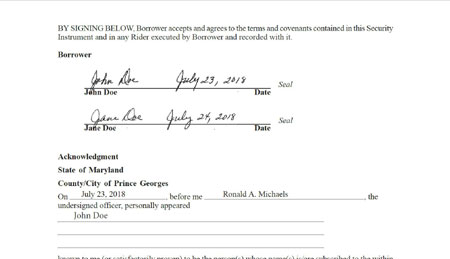
Elaine Wright Harris
In Maryland, a Notary certificate form (often called a loose certificate) is a separate sheet containing acknowledgment or other wording for a notarial act that may be attached to another document. Certificate forms are commonly used by the mortgage industry to correct improperly notarized documents or complete notarizations for multiple signers in different locations or at different times. A certificate form may not be used to correct a notarization if the Notary failed to observe or witness the signature of the signer.
Maryland regulations
Section 01.02.08.02.A. of the Code of Maryland Regulations outlines the steps a Notary Public must follow when taking an acknowledgment:
- Obtain satisfactory proof of identity of the individual signing the document;
- Observe the signing of the document if the document is not previously signed;
- Take the spoken statement of the individual signing the document that the document is the individual's free act and deed;
- Complete and sign the notary certification of the document;
- Apply the notary seal to the document;
- Note the date the notary's commission expires on the document; and
- Record the notarization in the notary's register of official acts.
Maryland’s Notary law and guidelines do not specifically prohibit Notaries from adding a certificate form to a document, but a Notary may not suggest to a signer or agency that a document requires one to be added. This can be interpreted as giving legal advice. Notaries may, however, add a certificate form if the signer or agency requests one. As a best practice, the Notary should document the request as proof that the Notary did not engage in the unlawful practice of law.
Below are two examples when a certificate form may be used and the proper procedures a Notary must follow in adding and completing the certificate form.
Missing notarial stamp or Notary signature
If a Notary fails to complete a notarization by omitting the Notary’s seal or signature on the document, a title company, closing agent or other agency may provide a new certificate form to correct the notarization.
In completing the certificate form, the Notary must add the correct venue, the name of the signer, the date the signer appeared, and the method of identifying the signer. Then, the Notary must sign the certificate and affix the Notary’s seal and commission expiration date.

Click to expand.
Multiple signers
Some mortgage loan signings may require documents to be signed by multiple signers before different Notaries at different times. These signings may be referred to as dual, split or half signings. In this case (see Attachment), the first borrower signs and dates (if applicable) the document in the presence of the first Notary. The Notary completes the notarization using the certificate wording preprinted on the document.
Then the title company, closing agent or other agency forwards the document, along with a new certificate form, to the second borrower. The second borrower signs and dates (if applicable) the document in the presence of the second Notary. The Notary completes the notarization for the document using the second certificate form by adding the correct venue, the name of the signer, the date the signer appeared, and the method of identifying the signer. Then, the Notary signs the certificate and affixes the Notary’s seal and commission expiration date.
Elaine Wright Harris of Bowie, Maryland, is the NNA’s 2009 Notary of the Year. She is a mobile Notary and long-time Notary educator and mentor. Questions or comments can be forwarded to thedeskofelainewright@comcast.net.